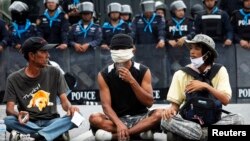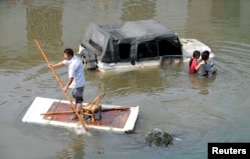BEIJING —
Authorities in eastern China dispatched riot police on Wednesday to guard against a resumption of anti-government protests after a day of clashes pitting security forces against thousands of victims of the worst floods in a century.
On Tuesday, residents of Yuyao city massed in front of the local government headquarters, denouncing what they decried as inadequate relief efforts and demanding the local Communist Party secretary and mayor step down.
Accounts on microblogs, supported by photographs posted on Sina Weibo, China's version of Twitter, said they vandalized the government building, using metal tools to pry loose and remove the party slogan “Serve the people” mounted at the entrance.
Photographs showed several residents bleeding from the head.
“We strongly condemn the shameless acts by the police and riot police for using any pretext to beat people,” said a microblogger from the city. But some Internet users said new legal rulings aimed at cracking down on rumors have deterred many from expressing opinions online.
Large numbers of riot police stood guard in the city of 1 million on Wednesday morning, according to photos posted by a Chinese rights group, Civil Rights and Livelihood Watch. The founder of the group, Liu Feiyue, told Reuters he had received the photographs from residents.
Communist party defends relief work
Party officials dismissed allegations of inaction and state media appealed for an end to the unrest in the city near the East China Sea coast in Zhejiang province.
State media said more than 70 percent of the town was flooded by the heaviest rainfalls in a century after typhoon Fitow hit eastern China.
Some 800,000 residents were affected, with the China News Service putting losses at nearly 7 billion yuan ($1.15 billion).
Local authorities have issued no casualty figures.
Cai Qi, a senior party official for Zhejiang province, urged residents not to “magnify” the protests.
“Who says there's been a failure of leadership?” Cai said in his microblog. “In the face of this unprecedented catastrophe, the leaders and cadres of all levels in Yuyao city have done everything possible for the typhoon relief efforts.”
State-run Yuyao Daily said in an editorial that residents should “express their rational demands at an appropriate time, and in a reasonable manner”.
Yuyao residents had already staged a mass protest last week against a regional television station for reports suggesting that flood-hit areas were back to normal.
State media reported on Monday that a Chinese official photographed being given a piggyback by a villager while visiting flood victims in Zhejiang was sacked after the image caused public outrage online.
But legal experts suggest Internet users may now be cautious about expressing opinions. A judicial interpretation by China's top court in September said bloggers can be prosecuted for posting rumors seen by more than 5,000 people, or forwarded more than 500 times.
Yang Xuelin, a Beijing lawyer, told Reuters that many people “are afraid to post comments on weibo now. State media has clear biases so if ordinary people have no voice, it is very difficult to know the truth.”
Yang pointed out that in 2012, microblogs played an important role in dissemminating information during floods in Beijing which killed at least 37 people.
On Tuesday, residents of Yuyao city massed in front of the local government headquarters, denouncing what they decried as inadequate relief efforts and demanding the local Communist Party secretary and mayor step down.
Accounts on microblogs, supported by photographs posted on Sina Weibo, China's version of Twitter, said they vandalized the government building, using metal tools to pry loose and remove the party slogan “Serve the people” mounted at the entrance.
Photographs showed several residents bleeding from the head.
“We strongly condemn the shameless acts by the police and riot police for using any pretext to beat people,” said a microblogger from the city. But some Internet users said new legal rulings aimed at cracking down on rumors have deterred many from expressing opinions online.
Large numbers of riot police stood guard in the city of 1 million on Wednesday morning, according to photos posted by a Chinese rights group, Civil Rights and Livelihood Watch. The founder of the group, Liu Feiyue, told Reuters he had received the photographs from residents.
Communist party defends relief work
Party officials dismissed allegations of inaction and state media appealed for an end to the unrest in the city near the East China Sea coast in Zhejiang province.
State media said more than 70 percent of the town was flooded by the heaviest rainfalls in a century after typhoon Fitow hit eastern China.
Some 800,000 residents were affected, with the China News Service putting losses at nearly 7 billion yuan ($1.15 billion).
Local authorities have issued no casualty figures.
Cai Qi, a senior party official for Zhejiang province, urged residents not to “magnify” the protests.
“Who says there's been a failure of leadership?” Cai said in his microblog. “In the face of this unprecedented catastrophe, the leaders and cadres of all levels in Yuyao city have done everything possible for the typhoon relief efforts.”
State-run Yuyao Daily said in an editorial that residents should “express their rational demands at an appropriate time, and in a reasonable manner”.
Yuyao residents had already staged a mass protest last week against a regional television station for reports suggesting that flood-hit areas were back to normal.
State media reported on Monday that a Chinese official photographed being given a piggyback by a villager while visiting flood victims in Zhejiang was sacked after the image caused public outrage online.
But legal experts suggest Internet users may now be cautious about expressing opinions. A judicial interpretation by China's top court in September said bloggers can be prosecuted for posting rumors seen by more than 5,000 people, or forwarded more than 500 times.
Yang Xuelin, a Beijing lawyer, told Reuters that many people “are afraid to post comments on weibo now. State media has clear biases so if ordinary people have no voice, it is very difficult to know the truth.”
Yang pointed out that in 2012, microblogs played an important role in dissemminating information during floods in Beijing which killed at least 37 people.





